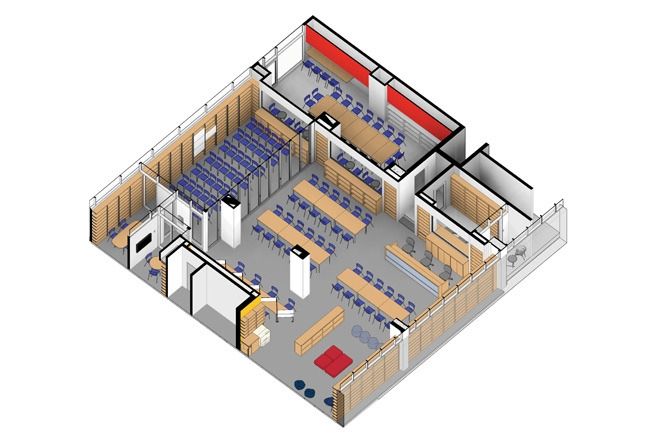Article by Adena Dershowitz, The Lycée Français de New York
Feature image courtesy of The Lycée Français de New York. This multi-use library space benefits from a more flexible design, which incorporates a movable glass partition for more formal teaching, as well as separate spaces for quiet study and collaboration.
At any school, shared spaces impact different stakeholders, and the two libraries at The Lycée Français de New York, a bilingual French school, are a prime example. They serve 1,360 students from 68 nationalities, from nursery through grade 12, in addition to their families. Given our unique French book collections, many parents use our libraries for their own reading as well as to find resources for their children that aren’t readily available elsewhere.
Eighteen months ago, I was appointed by the head of school to co-lead the redesign of the libraries with our CFOO, Thierry Pourchet. We aimed to develop a process that would include the voices of as many different stakeholders as possible. I also wanted stakeholders to give their honest opinions about their needs and wants, and avoid undue influence from school administrators and design partners.
We started by communicating among ourselves and our primary partners. Our architects, Susan T. Rodriguez and Ennead Architects, met with student council representatives and groups of faculty. A library redesign committee co-chaired by our CFOO and myself included faculty, librarians, students, trustees, parents, administrators, the architects and our owner's representative. A ninth-grade interior design class also offered student-developed models of library designs that took into account different school needs.
Concurrently, we decided to hire an outside research assistant (RA) to minimize bias in collecting feedback from a larger number of stakeholders. The RA would gather qualitative data through one-on-one interviews with students, faculty, librarians and parents.
The RA’s job description made clear the school’s overarching research question: "How well do the school’s current library spaces serve our goal of assuring that students develop 21st-century literacy skills including reading, information and media literacy and project-based learning?" We aimed to both understand how community members used the current library and gather their ideas for a new design.
The RA’s responsibilities included:
- Working with the Lycée team to write interview questions for varying stakeholder groups
- Suggesting the types of interview participants who would represent the diverse Lycée community
- Conducting more than 50 interviews with students, faculty and parents
- Recording audio and transcribing interviews
- Analyzing transcriptions to map results and define trends
- Providing a report to the project team along with key recommendations
The hiring process was typical, with candidates providing application materials, and finalists invited to interview in person. The position was paid hourly, and the school stipulated the work should be completed in about 150 hours over four months.
Should your school be thinking of hiring an RA, I would recommend a school staff member, and ideally the project manager, be available to help the RA navigate the school community, manage logistics, and prioritize communication with constituents. Someone familiar with the environment and the project will need to explain to the RA the context of the project and build connections within the community. I helped the RA set up interviews, for example, and ensured the selection of interviewees represented the Lycée’s diverse stakeholders.
Keys to success include hiring an RA, assigning management responsibilities to both operational and pedagogical staff members, and giving ourselves two school years to embark on the inclusive design and feedback process.
Our first renovated library is due to open this fall, and we are confident our inclusive process has led to a space that our varied stakeholders will use and enjoy. In fact, we are planning to use a similar process if we approach learning space design in the future. Keys to success include hiring an RA, assigning management responsibilities to both operational and pedagogical staff members, and giving ourselves two school years to embark on the inclusive design and feedback process. Taking the time to get it right for the community is important.
One teaching philosophy that guides my work is the Reggio Emilia approach, whose founder Loris Malaguzzi defined the learning environment as “the third teacher.” Malaguzzi recognized how strongly space and materials influence adult and child behavior, how they shape the perception of what happens and what matters in our schools. Collecting stakeholders’ opinions about what learning spaces could and should be can help schools make the best decisions about this major part of our pedagogy and value proposition.



